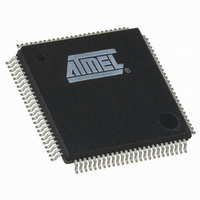ATSAM3S4CA-AU Atmel, ATSAM3S4CA-AU Datasheet - Page 79

ATSAM3S4CA-AU
Manufacturer Part Number
ATSAM3S4CA-AU
Description
IC MCU 32BIT 256KB FLASH 100LQFP
Manufacturer
Atmel
Series
SAM3Sr
Specifications of ATSAM3S4CA-AU
Core Processor
ARM® Cortex-M3™
Core Size
32-Bit
Speed
64MHz
Connectivity
EBI/EMI, I²C, MMC, SPI, SSC, UART/USART, USB
Peripherals
Brown-out Detect/Reset, DMA, I²S, POR, PWM, WDT
Number Of I /o
79
Program Memory Size
256KB (256K x 8)
Program Memory Type
FLASH
Ram Size
48K x 8
Voltage - Supply (vcc/vdd)
1.62 V ~ 1.95 V
Data Converters
A/D 16x10/12b, D/A 2x12b
Oscillator Type
Internal
Operating Temperature
-40°C ~ 85°C
Package / Case
100-LQFP
Controller Family/series
ATSAM3S
No. Of I/o's
79
Ram Memory Size
48KB
Cpu Speed
64MHz
No. Of Timers
6
Rohs Compliant
Yes
Processor Series
ATSAM3x
Core
ARM Cortex M3
3rd Party Development Tools
JTRACE-CM3, MDK-ARM, RL-ARM, ULINK2
Development Tools By Supplier
ATSAM3S-EK
Cpu Family
AT91
Device Core
ARM Cortex-M3
Device Core Size
32b
Frequency (max)
64MHz
Total Internal Ram Size
48KB
# I/os (max)
79
Number Of Timers - General Purpose
6
Operating Supply Voltage (typ)
1.8/3.3V
Operating Supply Voltage (max)
1.95/3.6V
Operating Supply Voltage (min)
1.62V
On-chip Adc
16-chx12-bit
On-chip Dac
2-chx12-bit
Instruction Set Architecture
RISC
Operating Temp Range
-40C to 85C
Operating Temperature Classification
Industrial
Mounting
Surface Mount
Pin Count
100
Package Type
LQFP
Lead Free Status / RoHS Status
Lead free / RoHS Compliant
Eeprom Size
-
Lead Free Status / Rohs Status
Details
Available stocks
Company
Part Number
Manufacturer
Quantity
Price
Part Number:
ATSAM3S4CA-AU
Manufacturer:
ATMEL/爱特梅尔
Quantity:
20 000
- Current page: 79 of 1118
- Download datasheet (24Mb)
10.11 About the instruction descriptions
10.11.1
10.11.2
6500C–ATARM–8-Feb-11
Operands
Restrictions when using PC or SP
The CMSIS also provides a number of functions for accessing the special registers using MRS
and MSR instructions:
Table 10-15. CMSIS intrinsic functions to access the special registers
The following sections give more information about using the instructions:
An instruction operand can be an ARM register, a constant, or another instruction-specific
parameter. Instructions act on the operands and often store the result in a destination register.
When there is a destination register in the instruction, it is usually specified before the operands.
Operands in some instructions are flexible in that they can either be a register or a constant. See
“Flexible second operand”
Many instructions have restrictions on whether you can use the Program Counter (PC) or Stack
Pointer (SP) for the operands or destination register. See instruction descriptions for more
information.
Special register
PRIMASK
FAULTMASK
BASEPRI
CONTROL
MSP
PSP
•
•
•
•
•
•
•
•
“Operands” on page 79
“Restrictions when using PC or SP” on page 79
“Flexible second operand” on page 80
“Shift Operations” on page 81
“Address alignment” on page 83
“PC-relative expressions” on page 84
“Conditional execution” on page 84
“Instruction width selection” on page
Access
Read
Write
Read
Write
Read
Write
Read
Write
Read
Write
Read
Write
.
CMSIS function
uint32_t __get_PRIMASK (void)
void __set_PRIMASK (uint32_t value)
uint32_t __get_FAULTMASK (void)
void __set_FAULTMASK (uint32_t value)
uint32_t __get_BASEPRI (void)
void __set_BASEPRI (uint32_t value)
uint32_t __get_CONTROL (void)
void __set_CONTROL (uint32_t value)
uint32_t __get_MSP (void)
void __set_MSP (uint32_t TopOfMainStack)
uint32_t __get_PSP (void)
void __set_PSP (uint32_t TopOfProcStack)
86.
SAM3S Preliminary
79
Related parts for ATSAM3S4CA-AU
Image
Part Number
Description
Manufacturer
Datasheet
Request
R

Part Number:
Description:
KIT EVAL FOR ATSAM3S4C
Manufacturer:
Atmel
Datasheet:

Part Number:
Description:
Development Boards & Kits - ARM EVAL KIT SAM3S8 & SAM3SD8 series
Manufacturer:
Atmel
Datasheet:

Part Number:
Description:
AT91 ARM Cortex M3-based Processor
Manufacturer:
ATMEL [ATMEL Corporation]
Datasheet:

Part Number:
Description:
DEV KIT FOR AVR/AVR32
Manufacturer:
Atmel
Datasheet:

Part Number:
Description:
INTERVAL AND WIPE/WASH WIPER CONTROL IC WITH DELAY
Manufacturer:
ATMEL Corporation
Datasheet:

Part Number:
Description:
Low-Voltage Voice-Switched IC for Hands-Free Operation
Manufacturer:
ATMEL Corporation
Datasheet:

Part Number:
Description:
MONOLITHIC INTEGRATED FEATUREPHONE CIRCUIT
Manufacturer:
ATMEL Corporation
Datasheet:

Part Number:
Description:
AM-FM Receiver IC U4255BM-M
Manufacturer:
ATMEL Corporation
Datasheet:

Part Number:
Description:
Monolithic Integrated Feature Phone Circuit
Manufacturer:
ATMEL Corporation
Datasheet:

Part Number:
Description:
Multistandard Video-IF and Quasi Parallel Sound Processing
Manufacturer:
ATMEL Corporation
Datasheet:

Part Number:
Description:
High-performance EE PLD
Manufacturer:
ATMEL Corporation
Datasheet:

Part Number:
Description:
8-bit Flash Microcontroller
Manufacturer:
ATMEL Corporation
Datasheet:











